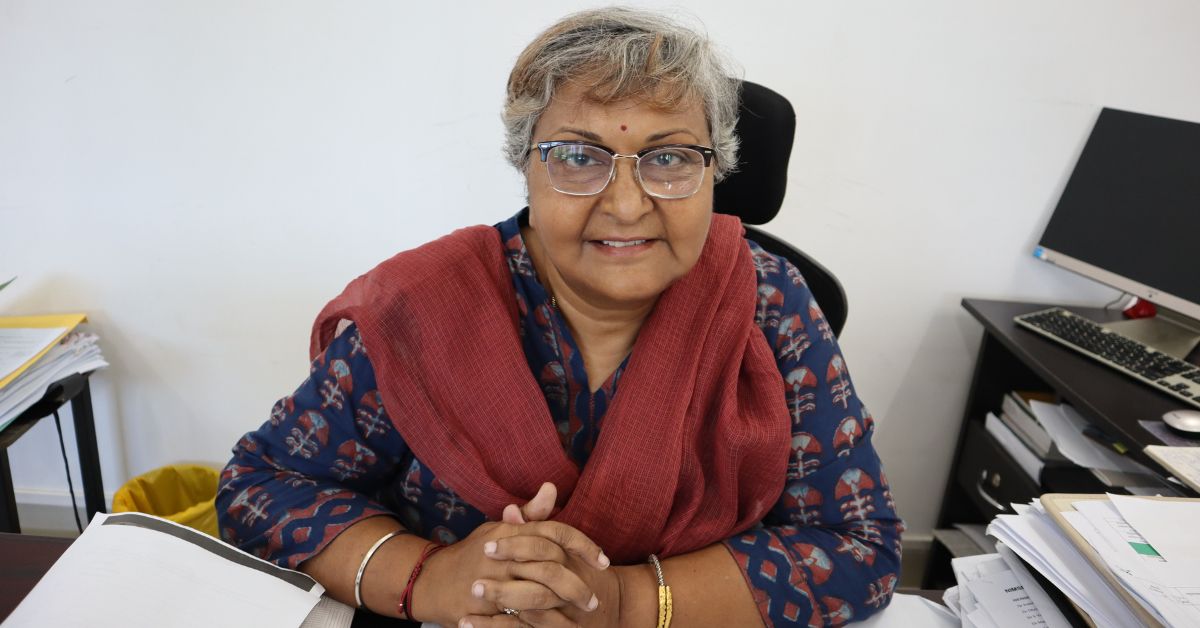“Name the bones of the foot in sequence.” Multiple hands shoot into the air. They belong to a batch of young girls and boys, twinning in their white lab coats.
One among them is picked on to answer the question. As Zavi Paphino rattles off the names of the bones, his confidence is unmistakable. The professor’s nod signals he has got the answer right.

This thrills Zavi, a first-year MBBS student and . He recalls the day he secured admission into the Nagaland Institute of Medical Sciences and Research (NIMSR) in Kohima, Nagaland. It felt like the moment had been a lifetime in the making.
When Zavi first dreamt of becoming a doctor, he resigned himself to the fact that he would — like numerous other Nagaland youth — have to move out of his home state to pursue his medical studies. The competition is fierce. Before the NIMSR was instated, the youth of Nagaland would hustle to secure admission to one of the 63 seats reserved for them in medical colleges across India.
These included 21 in the Northeastern states of Manipur, Meghalaya, and Tripura. Studying in their home state was not an option. You see for 61 years since attaining statehood in 1963 — the state was a part of Assam following Independence — Nagaland did not have .
In 2023 the National Medical Commission approved NIMSR to take in its first batch of 100 MBBS students for its inaugural academic session 2023-24. The youth of the Northeastern state saw this decision as a lifeline to their dreams. One of the brightest minds of his batch, Zavi recalls the monumental decision, saying, “I felt relieved.
The other option would be to move to Assam or Shillong to attend the medical college there. Studying in the same state where I was born makes me feel fortunate; I feel lucky to be among the first batch of medical students. The fact that I live 30 minutes away from college feels amazing.
” Zavi’s seniors weren’t as lucky. “They had to move to Bihar, Delhi, and other Northeastern states for their medical education.” But even as the evoked applause and made headlines soon after its inaugural in 2023, little is known about the dean cum director Dr Soumya Chakraborty who pioneered the project.
The 60-year-old has been the force behind new improvements, facilities, and upgrades at NIMSR. A mainstay of her approach, she insists, has been perseverance and a ‘never back down’ attitude. A call that changed the roadmap of her life Dr Soumya’s take on life has always been unconventional.
Following a medical degree from Kolkata and a master of science in anatomy from the Institute of Medical Sciences BHU, Uttar Pradesh, one would think Dr Soumya was well on her way to being a physician. But a close look at the timeline of her professional journey will reveal she harboured another love; that of being a teacher. Her stint at the BP Koirala Institute of Health Sciences in Dharan Nepal from 1995 to 2013 — where she went from being an assistant professor to establishing the anatomy department at the college, followed by rising to the post of dean — exemplifies her love for taking the lead and .
During this time, her expertise took her globetrotting to Scotland, the Netherlands, Sweden, the Philippines, and Egypt. In 2013, Dr Soumya returned to her home state Kolkata and began work at the ESI Post Graduate Institute of Medical Sciences and Research, Joka. Here, she held the post of dean.
But the pièce de resistance of her journey was an opportunity in 2021. “I was requested by the Government of India’s then labour minister Bhupender Yadav to set up the medical college in Bihar,” Dr Soumya states. Now known as ESI Medical College and Hospital in Bihta, she shares that while the college was sanctioned by the Government of India in 2019 and the construction had been completed, the college hadn’t started functioning yet.
“I was sent there by the labour ministry to start the college as founder dean,” she notes. Dr Soumya conceded to go. When asked how she managed the project in the wake of the COVID-19 pandemic, she simply says, “The collaboration and cooperation by the State Government helped expedite things.
I have realised that barriers can always be overcome. All you need to do is take challenges and turn them into opportunities.” Reeling from this success, Dr Soumya returned to her role as dean in Kolkata.
But then she got a call. “He [Bhupender Yadav] was keen that I go to Nagaland and help set up the medical college there,” she smiles. ‘Family is important; career is too’ In 2018, the spoke to six individuals from Nagaland to get their insights on one question: Do you feel alienated? What stood out for me was how many of the responders said that their fear of discrimination had forced them to live a life of confinement.
They never ventured outside their home territory. The article sheds light on how perceptions about the Naga community are often rooted in stereotypes. And Dr Soumya, who was debating a move to the Northeast in 2022, was confronted with this reality.
“People have various stigmas around Nagaland. This was creating a challenging situation for me amongst my friends and family,” she sighs. Though the reasons to stay back in Kolkata were stronger — a lucrative and steady job, a great family, and a home — she says, an “inner calling” compelled her to choose Option B.
“I had heard of how the had to travel to other states for medical education,” she recalls. But I am intrigued. Does this circumstance go beyond a travel inconvenience? I decided to check with Zavi.
“Yes,” he affirms. “I’ve heard from some friends and seniors who have moved to Rajasthan and Gujarat that they face instances of discrimination because of their appearance. They tell me how their peers put up boundaries and aren’t very friendly.
” While Zavi assures me that the discrimination does not cross the line and is not of a serious nature, he adds, “I would maintain that staying in our own state and having local friends makes it easier for those of us who study in Nagaland.” Dr Soumya had heard these stories from friends of hers who lived in the Northeast. And soon, being a part of the solution overrode every other priority of hers.
In 2022, she quit her job as dean and took a flight to Nagaland. Well aware of the domino effect of her decision, Dr Soumya says, “I knew my move would mean leaving my family behind. My husband is the principal of Tomo Riba Institute of Health and Medical Sciences — Arunachal Pradesh’s first medical college.
He couldn’t leave to come with me. Neither could my daughter who is a lawyer in Delhi.” How tough was it to make this knowing she was leaving the safety of the known to dive into the deep end? The satisfaction trumps the fear, she says.
“I believe every woman has the potential to be a leader. A woman’s absence from the family for a certain period of time should not make much of a difference because every person in the family should bear the ownership as an equal,” Dr Soumya points out. She continues, “Whenever a woman decides to do something, there are bound to be 100 questions and 200 ‘no’s.
But if her mind says even one ‘yes’, she should go for it.” Considering herself fortunate for having her parents’, husband’s and daughter’s full support, Dr Soumya shares, “This is why I have been able to take up these adventures. I knew until and unless I put myself forward, I’d never know if I was capable of navigating these roles.
” It is easier said than done. Acknowledging that she often finds it tricky to balance her professional and personal life as a mother, she says, “But I have been blessed with support and help. When my daughter was younger, evenings were a tough time.
She would want me with her. At the time, mobile phones weren’t as popular. And there was little I could do.
” But despite the dilemmas and the impasses, Dr Soumya encourages women to never put their dreams on the back burner. “Nothing is impossible in this world,” she says. “But that being said, it’s only you who can make it possible.
” She to find their life purpose. “Not everyone loves setting up a college. You may have different dreams, but you need to be ready to move beyond where you are to find your breakthrough,” she is insistent.
And with these ideals backing her, Dr Soumya took the reins of developing Nagaland’s first medical college. The 12th of December 2022 will always be a day etched in her memory as it was the day she set foot in the college. Navigating a new landscape Every morning as Dr Soumya walks into the anatomy class to see enthusiastic faces, she says it is all the validation she seeks.
“I see gratitude on their faces.” Currently, 100 students are studying at the college. While the well-oiled wheels of the institute are chugging well, when Dr Soumya first started, the scene was contrastingly different.
One of the things that baffled her the most was the topography of the region. Elaborating on this, she says, “It is a mountain terrain. Nagaland is one of the farthest Northeast hilly states.
While setting up the , we realised these were sinking zones — areas made of red soil and no stones. So, we needed a new construction pattern. Each time we would try constructing, water would begin gushing out of the earth.
” The team then came up with the idea of retention walls to support the construction. Students bask in the view from the top; NIMSR is on a hill; but what is a luxury today was a point of contention during the construction, due to rainfall and landslides. The topography did not prove to be a hurdle only in the beginning but even today when urgent supplies are needed.
“While we have vendors, getting supplies delivered to a spot on a hill is much tougher than plain region. Deliveries take time and require flight,” Dr Soumya points out. However, the team has found a solution to this.
Pre-stocking, ordering in advance, and being prepared, preempt a scenario in which stock runs out. Once the infrastructure was complete, the next challenge was . Being in the far Northeast means Kohima is not the first choice of those who are looking for a job change.
But Dr Soumya stands proud of the team of 500 staff who are spread across the hospital and medical college. Not to forget her “dream team of three” — Lilly Ezung, technical consultant; Tali Jamir, procurement consultant and A Solo, hospital administrator — who, she says, have been working day and night since 2022 to see the project to fruition. “If I lose one of them, then the college may collapse.
They are the heart of the college,” she points out. The curriculum is designed in line with the National Medical Commission standards with subjects such as anatomy, gynaecology, and surgery along with a focus on clinical exposure. “We also follow the Medical Council of India’s AETCOM (attitude, ethics and communication module).
This is a community-oriented curriculum with family adoption programmes in rural setups of the state to ensure that no one in society is left out.” With over 30 laboratories — for micro-anatomy, histopathology, bacteriology, etc — the college is equipped with everything a medical student would need. On most days, Zavi can be found in the anatomy lab, brushing up on the names of the different bones.
“My experience at the college has been really great so far. I learn so much and am given so many opportunities. The facilities have helped me understand concepts better.
I know of youth who are working hard day and night to get into this college, and it is a step towards of Nagaland,” he smiles, going back to the bones. This opinion was seconded by Ritu Thurr, Nagaland’s former principal director for health and family welfare, who mentioned in an interview that he anticipated that young doctors from NIMSR would enhance tertiary-level care within the state, eliminating the need for patients to seek specialised medical services in places like Assam or Manipur. Meanwhile, Dr Soumya takes pride in speaking about the state-of-the-art facilities at the college.
“We have four lecture theatres with , a central library building that was funded by the World Bank, a 330-bed hospital (which will be extended to 530 in the coming months), an upcoming 14-storey building that is set to be constructed by the Japan International Cooperation Agency (JICA) — which will have a private helipad and drone area, staff quarters, dining halls, a hostel that can accommodate 250 students, and a sports complex.” Dr Soumya’s claims have confirmed that the 120-acre land is brimming with potential. The academician and doctor has a bone to pick with those who consider setting up a medical college a day’s job.
“It needs an extreme amount of dedication,” she emphasises. “But I am sure the NIMSR will grow further.” And pausing for a second, she smiles.
“I wouldn’t be surprised if it becomes one of the best medical colleges.”.



















